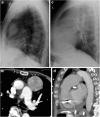Pulmonary fibrosis on the lateral chest radiograph: Kerley D lines revisited
- PMID: 28786002
- PMCID: PMC5621990
- DOI: 10.1007/s13244-017-0565-2
Pulmonary fibrosis on the lateral chest radiograph: Kerley D lines revisited
Abstract
The retrosternal clear space (RCS) is a lucent area on the lateral chest radiograph located directly behind the sternum. The two types of pathology classically addressed in the RCS are anterior mediastinal masses and emphysema. Diseases of the pulmonary interstitium are a third type of pathology that can be seen in the RCS. Retrosternal reticular opacities, known as Kerley D lines, were initially described in the setting of interstitial oedema. Pulmonary fibrosis is another aetiology of Kerley D lines, which may be more easily identified in the RCS than elsewhere on the chest radiograph.
Teaching points: • The RCS is one of three lucent spaces on the lateral chest radiograph. • Reticular opacities in the RCS are known as Kerley D lines. • Pulmonary fibrosis can be seen in the RCS as Kerley D lines. • Kerley D lines should be further evaluated with chest CT.
Keywords: Lung diseases, interstitial; Multidetector computed tomography; Pulmonary emphysema; Pulmonary fibrosis; Thoracic radiography.
Figures









Similar articles
-
Kerley B lines in the lung apex - a distinct CT sign for pulmonary congestion.Swiss Med Wkly. 2019 Sep 2;149:w20119. doi: 10.4414/smw.2019.20119. eCollection 2019 Aug 26. Swiss Med Wkly. 2019. PMID: 31476240
-
Kerley A-lines represent thickened septal plates between lung segments in patients with lymphangitic carcinomatosis: confirmation using 3D-CT lung segmentation analysis.Jpn J Radiol. 2022 Apr;40(4):367-375. doi: 10.1007/s11604-021-01215-4. Epub 2021 Nov 9. Jpn J Radiol. 2022. PMID: 34750736 Free PMC article.
-
[Evaluation of the retrosternal space and the retrocardiac space on normal left lateral radiographs of the chest].Nihon Igaku Hoshasen Gakkai Zasshi. 1996 Apr;56(5):251-6. Nihon Igaku Hoshasen Gakkai Zasshi. 1996. PMID: 8692648 Japanese.
-
[Increased pulmonary arterial and venous pressure].Radiologe. 2022 Feb;62(2):120-129. doi: 10.1007/s00117-021-00951-y. Epub 2021 Dec 30. Radiologe. 2022. PMID: 34967911 Review. German.
-
[Combined pulmonary fibrosis and emphysema].Presse Med. 2007 Jun;36(6 Pt 2):936-44. doi: 10.1016/j.lpm.2007.03.005. Epub 2007 Apr 18. Presse Med. 2007. PMID: 17446036 Review. French.
References
-
- Proto AV, Speckman JM. The left lateral radiograph of the chest. Med Radiogr Photogr. 1980;56(3):38–64. - PubMed
-
- Heitzman ER, Markarian B, Solomon J. Chronic obstructive pulmonary disease. A review, emphasizing roentgen pathologic correlations. Radiol Clin N Am. 1973;11(1):49–75. - PubMed
-
- Webb WR, Higgins CB. (2010) Thoracic Imaging: Pulmonary and Cardiovascular Radiology 2ndEdition. Lippincott Williams & Wilkins
Publication types
LinkOut - more resources
Full Text Sources
Other Literature Sources

